
Pheidole is a genus of ants that belongs to the ant subfamily Myrmicinae. The genus is widespread and ecologically dominant. It probably includes more than 1000 species. The genus first evolved in the Americas, eventually spreading across the globe.
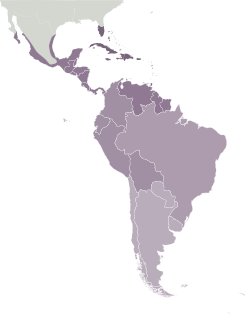
Pheidole harrisonfordi is a species of ant in the genus Pheidole. P. harrisonfordi lives in the Americas, mostly in neotropical countries such as Belize, Colombia, southern Mexico, Panama, Guatemala and other central American nations. It primary lives in Santa Bárbara, Honduras 700 metres (2,300 ft) above sea level. The ant also inhabits wet forest leaf litter at a elevation of 1,600 metres (5,200 ft) above sea-level. P. harrisonfordi was named after the actor Harrison Ford in honor of his work in tropical conservation. Minor workers have a head length of 0.41 millimetres (0.016 in) and a head width of 0.38 millimetres (0.015 in). The head of minor workers are flattened with the mesonotal suture absent. Major workers have a head length of 0.78 millimetres (0.031 in) and a witdh of 0.75 millimetres (0.030 in).

Carebara diversa, is a species of marauder ant widely distributed throughout Asia.
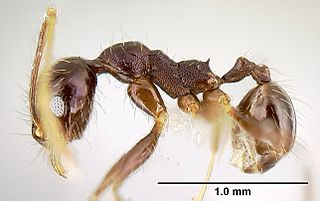
Pheidole purpurea is a dimorphic species of ant found in Mexico and Central America. The species shows considerable variance in physical characteristics based on location, though some variance exists even within small populations. Some populations display a metallic, purple sheen.

Pheidole megacephala is a species of ant in the family Formicidae. It is commonly known as the big-headed ant in the USA and the coastal brown ant in Australia. It is a very successful invasive species and is considered a danger to native ants in Australia and other places. It is regarded as one of the world's worst invasive ant species.

Chimaeridris is a small genus of ants in the subfamily Myrmicinae. The genus contains two species known from tropical Asia. Their unique hook-shaped mandibles and similar appearance to Pheidole minor workers raises the possibility that the genus is a slave-maker of Pheidole ants or a specialized predator.
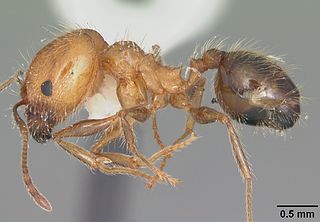
Pheidole dentata is a species of ant in the subfamily Myrmicinae. It is distributed in North America, from the Mid-Atlantic states and southeastern United States to Mexico.

Pheidole clavata is a species of ant in the genus Pheidole. Pheidole clavata inhabits Eastern and Northern Africa. This species of Pheidole, like many others, are dimorphic, which means that a colony may contain one or several queens. Each colony is made up of two castes: the "minor" workers, and the "major" workers, or "soldiers". The majors have large heads that they use as both weapons and tools to cut open large prey for the colony. The latter generally have enormous heads and mandibles in comparison to their usually fairly modest body size.

Pheidole metallescens is an ant, a species of higher myrmicine in the family Formicidae.

Pheidole vistana is a species of ant and a higher myrmicine in the family Formicidae.

Pheidole moerens is an ant, a species of higher myrmicine in the family Formicidae.

Pheidole rhea is a species of ant and a higher myrmicine in the family Formicidae.

Pheidole tysoni is a species of ant and a higher myrmicine in the family Formicidae.

Pheidole californica is an ant, a species of higher myrmicine in the family Formicidae.

Pheidole obtusospinosa is a species of ant and a higher myrmicine in the family Formicidae.

Pheidole pilifera is a species of ant and a higher myrmicine in the family Formicidae.

Pheidole hyatti is an ant, a species of higher myrmicine in the family Formicidae.
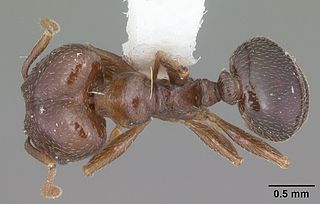
Pheidole crassicornis is an ant, a species of higher myrmicine in the family Formicidae.
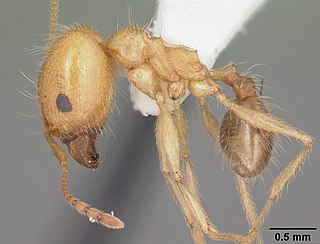
Pheidole morrisii is a species of ant and a higher myrmicine in the family Formicidae.

Pheidole dentigula is an ant, a species of higher myrmicine in the family Formicidae.





















